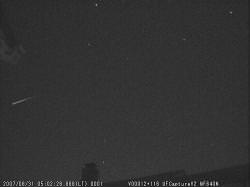I just wanted to give you all another gentle reminder about the Aurigid Meteor Shower, due to light the heavens on September 1st, 2007. Although the shower won’t peak until early tomorrow morning, astrophotographer John Chumack has already captured one on camera, and made a little video of its path through the skies. Now, we don’t know if this meteor shower is going to be amazing or boring, it’s all a mystery.
John had an automated camera pointed East on morning of August 31st, 2007, and captured a meteor streaking out of the constellation Auriga. John estimates that the meteor brightened to about 0.1 magnitude before fading away. John created a quick video of the meteor, and overlaid the constellation Auriga, so you can get a sense of direction. The video is a Windows movie file (WMV), and it’s about 850 kb. Click here to download the movie. Check out John’s website here for more amazing space images.
As I mentioned in an earlier article, the Aurigids are the dusty remnants from Comet Kiess. This long-period comet has only visited the inner Solar System twice in the last two thousand years – its last visit was in 83 BC. During that visit, the comet put down a trail of material that’s been drifting towards the Earth’s orbit ever since.
And on September 1st, 2007, our planet will cross this dusty trail for the first time. Will it be spectacular or boring? Nobody knows, we’ve never hit this dust trail before.
The outburst peaks on September 1st at 11:36 UT. In other words, for folks in Europe, that’s in the middle of the day. Not great timing. For me here on the West Coast of Canada, that’s 4:36 am PDT. The whole event should last about 2 hours, and be visible from California, Oregon, Hawaii and the Eastern Pacific Ocean.
But you never know what’s going to happen. If you’re feeling adventurous, check out the show. Get up a few hours before dawn, or watch in the early evening, and see if you can spot some meteors. And as always, let me know how it goes.

